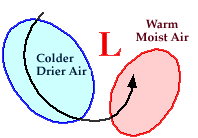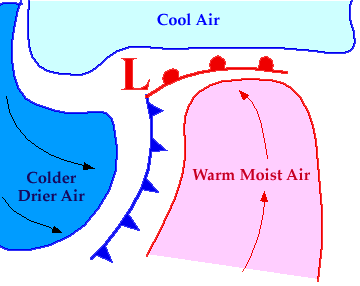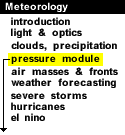
|
Cyclones play a crucial role in the earth's distribution of heat and moisture. Counterclockwise winds associated with cyclones transport large amounts of heat and moisture from lower to higher latitudes. Think of the surface winds around a center of low pressure as the swirling waters of a whirlpool, where the water spins around and towards the center. A similar circulation is associated with a midlatitude cyclone, where at the surface, wind spin counterclockwise and inward towards the center of low pressure.

|
As the cyclone intensifies, (central pressure drops), counterclockwise winds around the low pressure center likewise intensify, transporting the air masses around the center of circulation. |
By superimposing fronts over the
low pressure center and the
air masses,
a top view of a midlatitude cyclone and accompanying air masses
might resemble something like the schematic diagram below:

Southerly winds east of the low transport warm and moist air northward and this moisture often contributes to the development of precipitation. A warm front marks the leading edge of this air mass. Behind the low, northerly winds transport colder and drier air southward, with a cold front marking the leading edge of this air mass.
|


